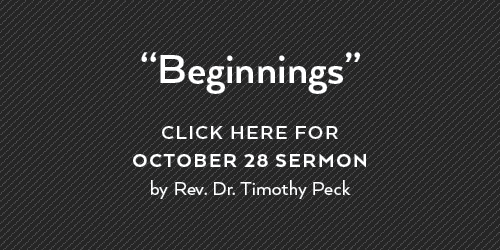Click for a PDF version
Monday
Read John 20:1-10, 19-23
A Surprise Visit
To understand Thomas’ response to his fellow disciples’ claims that they had seen the Lord, we need to revisit the experience of the rest of the disciples. Today’s text recounts that experience. The timing of this event is specified as: “On the evening of that first day of the week” (20:19). This obviously refers to the opening verse of chapter 20, which begins, “Early on the first day of the week, while it was still dark …” (20:1). The appearance of Jesus to His disciples, therefore, took place on the evening of His resurrection. The picture John paints of the disciples is one of confusion (v. 9) and fear (v. 19). They had gathered in their room and locked the door to avoid arrest. Having seen what had happened to their Lord, they probably feared for their lives.
In this context, Jesus suddenly appeared to them and offered them peace. He showed them His wounded hands and side and their fear immediately turned to joy (v. 20). Jesus proceeded to reassure them of His peace and commissioned them as those sent by Jesus as He had been sent by the Father (v. 21). He then breathed on them and said, “Receive the Holy Spirit” (v. 22).
Although Christians today have a Trinitarian understanding of the Holy Spirit as one person of the Triune God, we should not assume the same was true for Jesus’ disciples. It was only a few days earlier that Jesus promised to send them a Paraclete, usually translated as “Comforter,” “Counselor,” or “Advocate” (15:26; 16:7, 13). Now He calls this One the “Holy Spirit” and urges His disciples to receive the Spirit. They needed the Spirit to have courage, wisdom, and perseverance to accomplish all that He expected of them.
In this text we see Jesus giving to His disciples exactly what they needed. In response to their fear, He gave them peace. In response to their confusion about His resurrection, He offered them visible proof that He was the risen, crucified Christ. In response to their uncertainties about “What next?” He gave them purpose. In response to their sense of inadequacy, He gave them His Spirit. Jesus knew what they needed and gave to them freely.
Questions
Which of your needs does Jesus already know fully? How does His Spirit want to meet those needs in your life? What has He called you to do?
Prayers
Three Angels Haiti
Loving Father, we praise You for Your provision and faithfulness! Despite the continuing social challenges in Haiti, You kept Three Angels Christian Academy open and its 315 students learning and growing. Though Three Angels’ staff needs to continue to be nimble and aware, You have spared them from gang-related harm. You are good beyond measure!
Tuesday
Read Genesis 2: 4-7; John 20:19-23
Life-giving Forgiveness
In today’s text we see Jesus breathe on His disciples and say, “Receive the Holy Spirit.” In both Hebrew and Greek, the words translated “Spirit” can also mean “breath,” so it is not surprising that the Spirit is given by Jesus’ breathing on the disciples. In Genesis 2:7, when God created Adam, His breath was the life-giving force that transformed Adam into a living being. Similarly, when Jesus breathes on the disciples, they receive the life-renewing Spirit and are commissioned with a ministry of forgiveness. Interestingly, this is the only mention of forgiveness in John’s Gospel.
While Jesus is “the Lamb of God, who takes away the sin of the world” (John 1:29), John does not record the stories found in the other gospels about Jesus pronouncing people’s sins forgiven or instructing His disciples about how many times they are to forgive others. Rather, John reserves his one story about forgiveness for this account of Jesus commissioning the disciples, sending them as the Father had sent Him (20:21). This suggests that forgiveness is an essential element of the disciples’ ministry.
In John’s theology, the disciples do not “take away sin”; only Jesus does that. But because the disciples have experienced the life-giving power of forgiveness—especially here in their post-resurrection encounter with Jesus after they had abandoned Him—so they are charged with a mission to share that life-giving power of forgiveness with others. In so doing, they become not only bearers of good news, but agents of God’s transforming grace.
The impact of this encounter with Jesus is evident in the fact that the disciples were “overjoyed when they saw the Lord” (v. 20) and in their eagerness to spread the news to Thomas the next time they were with him (vv. 24-25). Imagine their feelings of joy, confidence, forgiveness, and purpose resulting from their encounter with Jesus. How could they not be eager to share the news of Jesus’ resurrection with others?
Questions
What has been your most profound experience of being forgiven? Whom might God be prompting you to forgive? How might seeing yourself as commissioned by Jesus to a ministry of forgiveness change the way you think of your relationships with others? How might it change your view of evangelism?
Prayers
Three Angels Haiti
Almighty God, You faithfully steered Three Angels Haiti through another fiscal year. Despite external social and political challenges, along with fundraising issues experienced by most everybody, Your provision enabled us to meet our fiscal 2024 financial plan. Thank you, Lord, for all that You have done and continue to do in Haiti!
Wednesday
Read John 20:24-31
Choosing Not to Believe
Given the fact that Thomas did not participate in the encounter with the risen Christ, it is little wonder that he struggled to believe the disciples’ news that they had seen the Lord. He was likely still suffering the same feelings of fear, shame, confusion, and uncertainty that the other disciples had experienced when they gathered in the locked room. Without a personal encounter with the post-resurrection Christ, it is understandable that he found the disciples’ news to be incredible.
It is tempting to speculate about the reasons for Thomas’ doubts. Perhaps he was simply a “show-me” type of guy, one who needed visible evidence to believe. Perhaps he was motivated by logic and rationality, unable to get beyond the realities he knew about Jesus’ trial, crucifixion, death, and burial. But John does not indulge our appetite for knowing why Thomas doubted. To pursue such a point is to miss the reason John (unlike the other Gospel writers) included this story.
John’s point in telling this story is conveyed in Thomas’ own words: “Unless I see the nail marks in His hands and put my finger where the nails were, and put my hand into His side, I will not believe” (v. 25, emphasis added). One of the hallmarks of John’s Gospel is John’s emphasis on believing. It is a core element of his Prologue in John 1: “He came to that which was His own, but His own did not receive Him. Yet to all who did receive Him, to those who believed in His name, He gave the right to become children of God” (vv. 11-12).
John uses the word “believe” more than twice as many times as the other three Gospel writers combined! In today’s text, Thomas states plainly, “I will not believe.” Although he conditions this on seeing the evidence of Jesus’ crucified body, his lack of belief is primarily a matter of the will. In this statement, John captures an essential element of unbelief—it requires a willingness to accept that God can do the impossible.
Questions
How often do we encounter people who will not believe in the crucified and resurrected Christ? How often do we lack the will to believe how God is working in our lives? Faith is not just accepting certain things as true but having the courage to respond to God’s call.
Prayers
Three Angels Haiti
Gracious Lord, Three Angels’ new fiscal year just commenced and our 2025 financial plan will be the most challenging yet. But You are a God of abundance, not of scarcity. Please stir current donors and prospective new supporters to generosity. Show those looking upon Haiti that You are the God who provides.
Thursday
Read John 20:24-31
From Doubting to Believing
This week’s text records the risen Christ’s encounter with Thomas, a week after He had appeared to the other disciples. They were in the same house, they had once again locked the doors, and Jesus once again greeted them with the reassurance, “Peace be with you” (20:26).
But this time Thomas was present. Jesus did not wait for Thomas to ask, “Is that really You, Lord?” Instead, He plainly instructed him to touch His hands and His side. In fact, Jesus used the same words Thomas had uttered to his fellow disciples when he said, “Unless I see the nail marks in His hands and put my finger where the nails were, and put my hand into His side, I will not believe” (20:25). Jesus knew what Thomas thought he needed to be able to believe and offered him that visible, physical evidence. But Jesus went a further step by giving Thomas a simple command: “Stop doubting and believe” (v. 27).
Thomas’ response to Jesus was immediate recognition of who He was and his full faith in Jesus: “My Lord and my God!” (v. 28), with echoes of Psalm 35:23 (“My God and Lord”). Thomas could no longer doubt the reports given to him by his fellow disciples about Jesus’ resurrection. He could not doubt that the One standing before him was the same One who had been nailed to the cross and whose body had been pierced with a sword. His initial doubts gave way to profound faith in his encounter with his risen Lord.
Jesus then spoke a word of gentle admonition to Thomas: “Because you have seen Me, you have believed; blessed are those who have not seen and yet have believed” (v. 29). It was good that Thomas had believed, but it would have been even better for him to believe without having to see for himself. It is important to recognize that Jesus does not criticize or belittle Thomas for his doubts. Doubts are a natural response to reports of miraculous events. But one would think that Thomas could have believed based on the strength of the unanimous report of his ten companions with whom he had shared life for the past three years, all affirming the reality of Jesus’ resurrection.
Questions
What is your bar for believing in Jesus’ resurrection? What doubts do you or did you need to overcome? How has your faith in Jesus changed?
Prayers
Three Angels Haiti
Our Creator and Redeemer, we place two Angel House orphans in Your care. Put Your holy, healing hands upon them, Father. Please provide the funding for a needed, new oxygen concentrator for one of our medical babies, Leilah. Lord, please put Your healing hand upon baby Betsaida—please make her well and help us fund her continuing cure.
Friday
Read John 20:24-31; 21:24-25
Models of Faith
The final verses of this week’s text form an editorial comment by the author. Having told his readers the stories of Jesus appearing to His disciples, both without Thomas and then when Thomas was present, John explains something of the purpose for writing this Gospel. First, he states, “Jesus performed many other signs in the presence of His disciples, which are not recorded in this book” (20:30). This is very similar to the final statement of the Gospel: “Jesus did many other things as well. If every one of them were written down, I suppose that even the whole world would not have room for the books that would be written” (21:25).
The final statement of the Book of John merely acknowledges that telling the story of Jesus requires an author to be selective, as there were too many teachings, actions, and personal encounters between Jesus and others to record them all. Considering all the books that have been written about Jesus since John wrote this Gospel—based on the very limited knowledge of Jesus’ life and ministry—one can certainly appreciate the truth of John’s statement.
But the statement after the story of Thomas has a different focus. Specifically, John says, “Jesus performed many other signs in the presence of His disciples.” Throughout this Gospel, John records seven miraculous signs Jesus performed: (1) turning water into wine at Cana (2:1-11); (2) healing the nobleman’s son in Capernaum (4:46-54); (3) healing the lame man at Bethesda (5:1-15); (4) feeding the 5,000 (6:1-15); (5) walking on water (6:16-21); (6) healing the man born blind (9:1-7); and (7) raising Lazarus from the dead (11:1-45).
Each of these signs was intended to help Jesus’ disciples and others believe in Him. John wants his readers to know that these were not the only signs Jesus performed, but simply the most salient ones. His reason for recording these signs was to lead people to faith in Jesus: “But these are written that you may believe that Jesus is the Messiah, the Son of God, and that by believing you may have life in His name” (20:31).
Thomas’ movement from doubt to belief in Jesus illustrates the trajectory of faith John wants all his readers to experience. Rather than being a negative example, Thomas is a model of the faith journey John wants others to follow.
Questions
Who are your faith role models? For whom are you a faith role model?
Prayers
Three Angels Haiti
Sovereign Savior, thank you for making last year’s Three Angels 9th grade startup successful! Please raise up new sponsors to support these children striving to better themselves and their country. Help the paperwork for little Steeve go through so that he can join his awaiting, adoptive Italian “forever family.” Thank you, Father, for loving the children in our care, for entrusting them to us!


